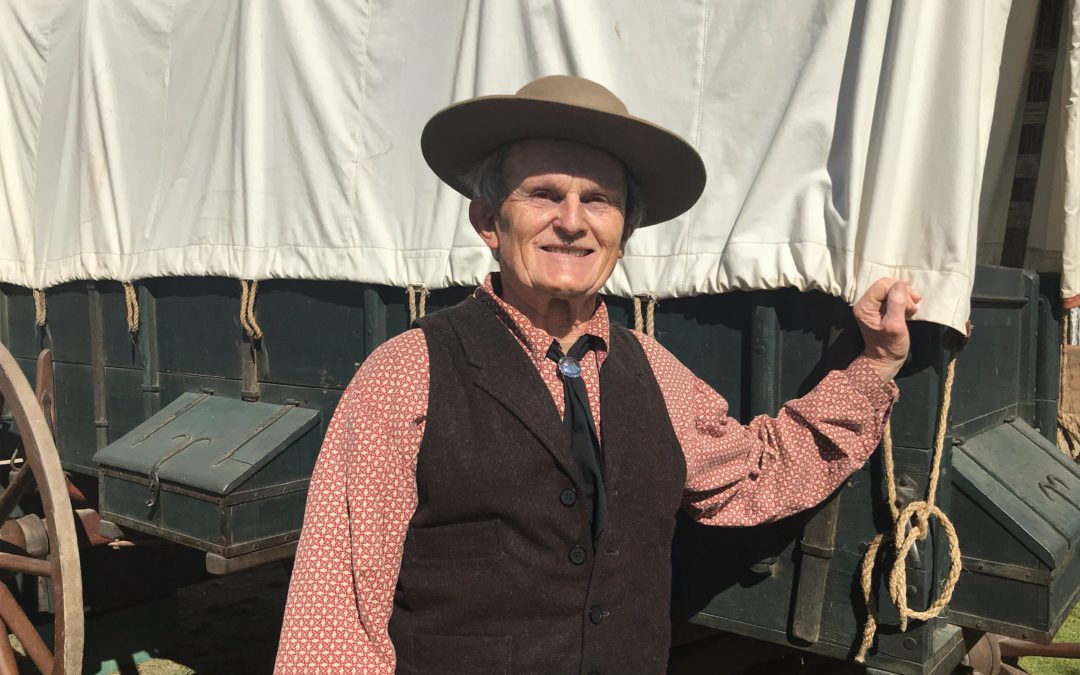Howdy Hoover has been a docent at Sutter’s Fort State Historic Park since 1987. He recently received the California Golden Poppy Award from California State Parks due to his exceptional volunteer service at Sutter’s Fort SHP.
How did you get involved?
As a single parent, I took my 4th-grade son to the overnight Environmental Living Program (ELP) at Sutter’s Fort. I was really impressed by ELP, the historic setting, and the amazing staff. That was in March 1987. I took the docent class that summer, became involved in the Living History Program, and married the docent coordinator (Katrina) that December. I have continuously been a docent at Sutter’s Fort for 32 years!
What’s your favorite part of volunteering?
Interpreting history in costume to children and the public.
What is it that you do in your role as a Sutter’s Fort volunteer?
I help interpret wagon travel at Sutter’s Fort during Demonstration Days and Hands on History events, teach parents and teachers about the covered wagon during training workshops for the Environmental Living Program, and have spent the past 30 years working the Sutter’s Fort “River Trip” / “Trappers’ Camp” Mobile Outreach Program in Red Bluff and Colusa, CA.
I developed maintenance programs for the active cannons and covered wagon at Sutter’s Fort, and was on the wagon committee that researched, arranged financing, and oversaw the construction of the covered wagon at Sutter’s Fort (on display since 2004),
What’s one of your favorite memories?
In the early 1990s, while driving through rural farmland south of Sacramento, I spotted an old wagon with a “for sale” sign on it. My friend, Bruce Turner, who led emigrant trail trips, was interested in purchasing a wagon. The next weekend he and his wife Barbara went to the farm, checked it out, and purchased it. It turned out to be an original wagon!
Judging from the fasteners and hubs I figured this was a post-Gold Rush vintage wagon. State Parks historian and military authority, George Stammerjohan, looked it over and thought it was a late 1800s military wagon. Bruce took the wagon home and did an extensive restoration to it. He removed the seat and brakes and set it up as an ox-drawn wagon. A custom trailer was built and it was towed to events with their Chevy Suburban. Bruce installed a slide out table under the bed with removable legs, bows, a canvas top, and many other items that an emigrant wagon would contain when purchased. The whole set-up really caught your eye and was very popular at trail history events.
My wife Katrina and I thought this would be perfect to display at Sutter’s Fort events. After all, Sutter’s Fort was the end of the 1840s California Trail. Katrina, being the docent coordinator at Sutter’s fort, talked my friend and his wife into becoming docents and taking the docent training classes. I talked Bruce into bringing the wagon to a few Sutter’s Fort events with the understanding that I would help with setup and tear down. The wagon was immensely popular and we later formed a wagon committee with the goal of raising funds and purchasing a covered wagon for Sutter’s Fort.
Unfortunately, Bruce’s health deteriorated and he passed away a couple of years after the Sutter’s Fort wagon arrived (June 2004). Barbara sold the wagon to State Parks employee Sharon Dennis who still takes the wagon to many historical events to this day.
We are proud to support the volunteer efforts at Sutter’s Fort SHP with the help of our sponsor, Sutter Health.
Learn how you can volunteer at Sutter’s Fort, or how you can support volunteer efforts.

